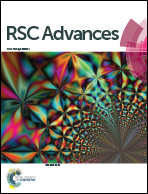MoSe2 nanosheets grown on carbon cloth with superior electrochemical performance as flexible electrode for sodium ion batteries†
Abstract
A flexible MoSe2/CF composite has been synthesized by a simple solvothermal method. MoSe2 nanosheets with a thickness of 20 nm are grown uniformly on the surface of the carbon fibers. The MoSe2/CF can be used as a self-supporting anode directly with superior electrochemical performance for sodium ion batteries.


 Please wait while we load your content...
Please wait while we load your content...